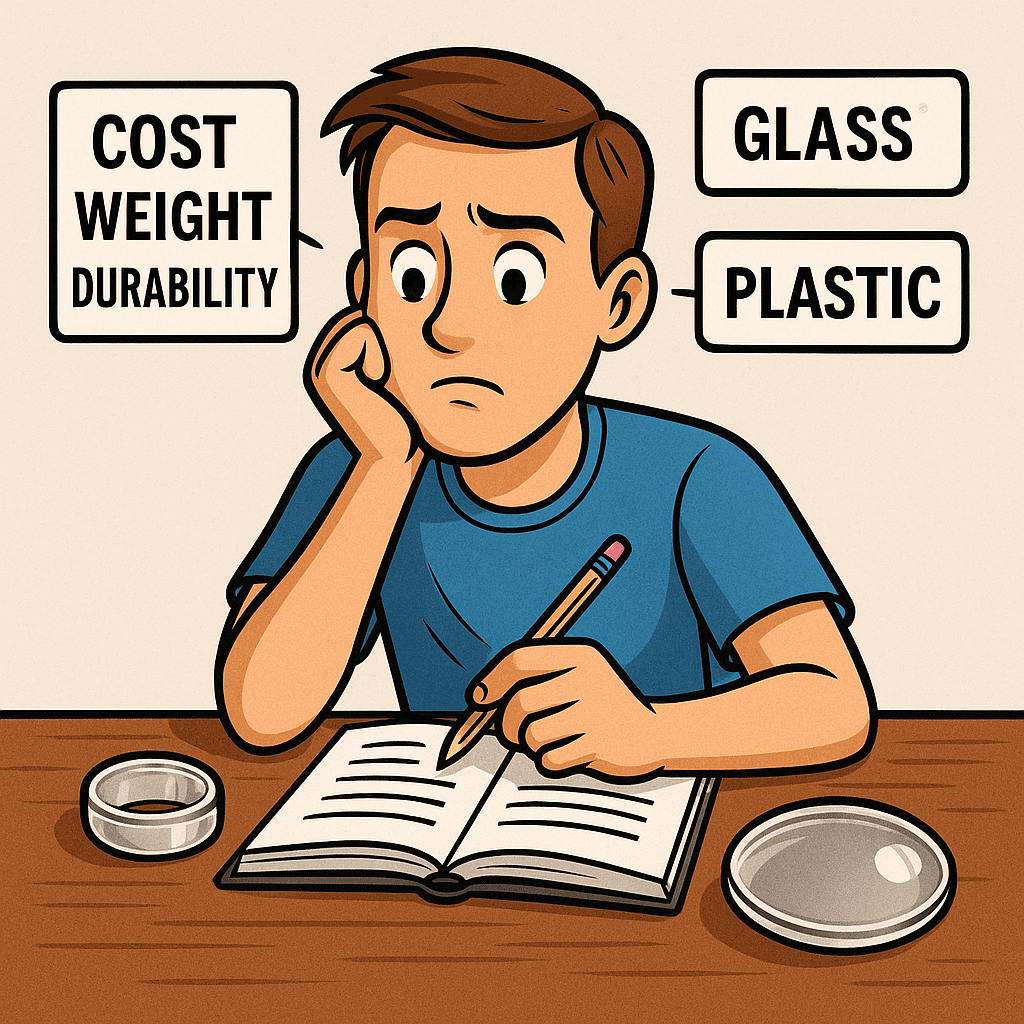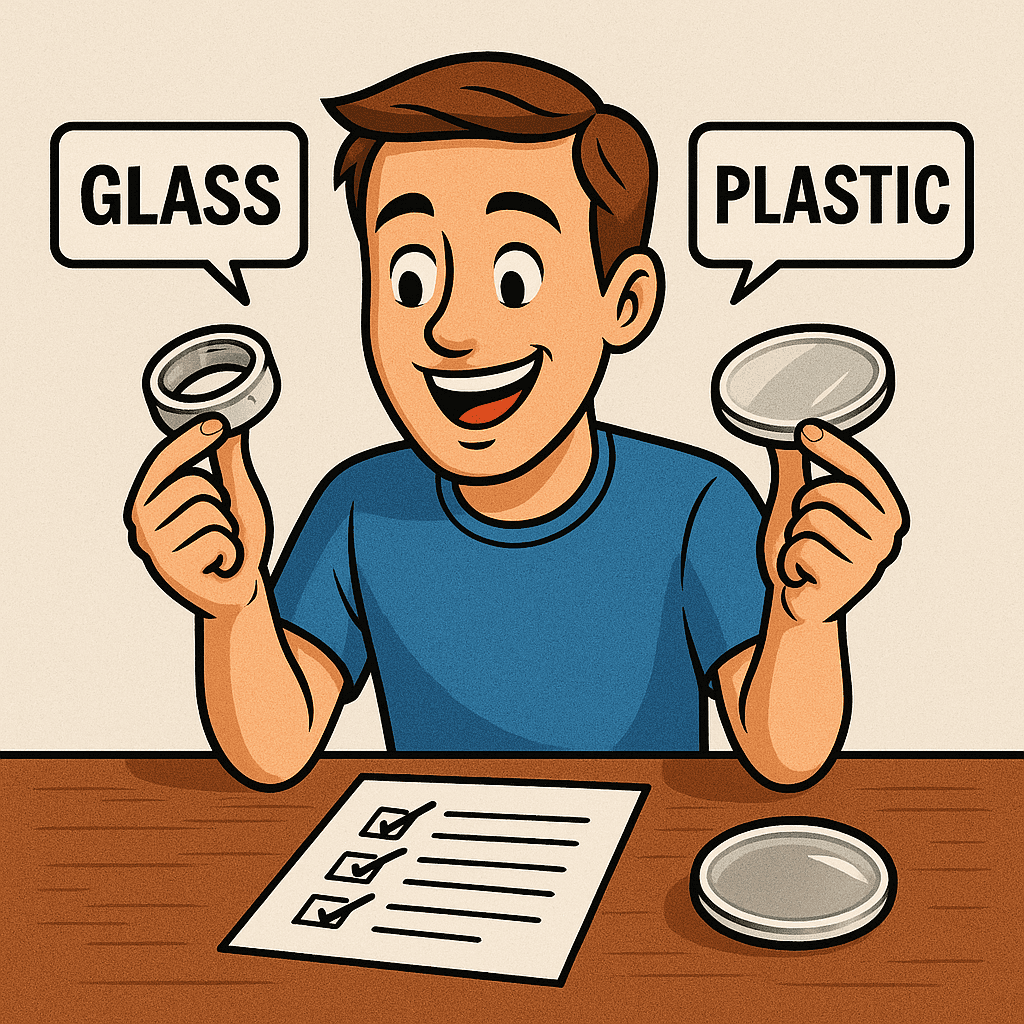
When it comes to optical system design, one of the most fundamental decisions is the choice between glass lenses and plastic lenses. While both technologies offer excellent performance under the right conditions, the trade-offs in cost, manufacturability, and application suitability can be significant.
In this article, we compare both materials using a practical example – a 25 mm bi-convex lens – and explore key aspects like cost structure, tolerance, and design flexibility. We also point out how optical requirements such as aspheric or freeform geometries influence material selection.
1. Cost Structure – Tooling vs. Per-Part Cost
Plastic lenses involve non-recurring engineering (NRE) costs due to the need for injection molding tools. However, once the tool is available, the per-part cost is typically much lower compared to glass.
Glass lenses, on the other hand, do not require tooling, as they are individually ground and polished. This makes them attractive for small volumes or prototyping – but the cost per piece remains relatively high.
We´re comparing cost levels here based on bi-convex Lens with a diameter of 25mm:
| Aspect | Plastic Lens | Glass Lens |
|---|---|---|
| Tooling (NRE) | Required low quantity tooling: 5.000 – 20.000€ high quantity tooling: 15.000 – 35.000€ | (usually) Not required For higher quantities or aspheric shaped tooling: < 5.000€ |
| Unit cost (low volume – <1000 pcs) | Moderate to high 5-25€ | Moderate to high 15-75€ |
| Unit cost (high volume – <10.000 pcs) | Low <2€ | Still moderate 8-15€ |
Conclusion: For series production, plastics typically offer better cost-efficiency. For low volumes, glass may initially appear simpler – but plastic lenses can also be prototyped without injection molding (see next section).
2. Prototyping Capabilities
Plastic optics are not limited to injection molding. Today, several rapid prototyping methods for plastics exist:
- Diamond turning (ideal for aspheres and high surface quality)
- CNC milling and polishing
(See our dedicated blog post: Prototyping)
These allow functional plastic lenses to be created quickly and cost-effectively, even for single pieces – closing the prototyping gap to glass.
Conclusion: Plastic prototyping is faster and more advanced than commonly assumed.
3. Optical Quality & Tolerances
Glass lenses offer:
- Extremely tight tolerances
- High surface quality (λ/4 and better)
- Outstanding thermal and chemical stability
Plastic lenses, depending on process and material, achieve:
- Very good optical clarity (especially in PMMA, COC, COP)
- Repeatability in volume production
- Sufficient tolerances for many imaging and light-guiding applications
However, plastic optics may be more sensitive to:
- Temperature-induced changes
- Scratching (if not coated)
- Long-term UV degradation (depending on material)
Conclusion: For ultra-precise systems and harsh conditions, glass is still the benchmark. For integrated systems with moderate requirements, plastic is more than sufficient.
4. Aspheric and Freeform Geometry
One of the key limitations in glass manufacturing is the ability to produce aspheric or freeform lenses cost-effectively. Such shapes typically require complex grinding and polishing setups.
Plastic optics, however, are ideally suited for:
- Aspheric surfaces
- Diffractive or Fresnel structures
- Integration of alignment and mounting features
These features can be replicated with high precision in a single molding cycle.
Conclusion: If your design requires complex or integrated geometries, plastic lenses offer major advantages.
5. Design Flexibility & Integration
Plastic lenses are lightweight and allow for:
- Built-in mounts and guides
- Combination with mechanical and optical functions
- Assembly-friendly geometries
Glass lenses are more traditional in form and often require additional hardware for mounting.
Conclusion: Plastic is more flexible for system-level integration.
6. Time-to-Market
- Glass: Advantageous for early-stage prototypes or quick feasibility tests
- Plastic: Longer ramp-up (if molded), but faster for mass production
Conclusion: For early evaluation, glass may be faster. For scalability, plastic has the edge – especially with prototyping options.
Final Thoughts
There’s no one-size-fits-all solution. The choice between glass and plastic depends on:
- Volume requirements
- Geometrical complexity
- Environmental conditions
- Performance expectations and budget
With today’s advanced manufacturing and prototyping technologies, plastic lenses can match or even surpass glass in many scenarios.
At ALL-IN OPTICS, we help you navigate this decision based on real application needs. Whether you need molded components, machined prototypes, or consulting for hybrid systems – we’re here to support your optics journey.
➡️ Contact us to explore the best optical material and manufacturing method for your project.

